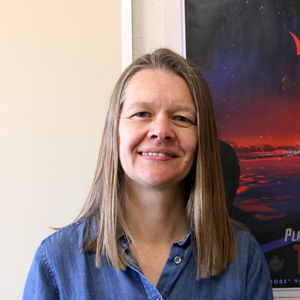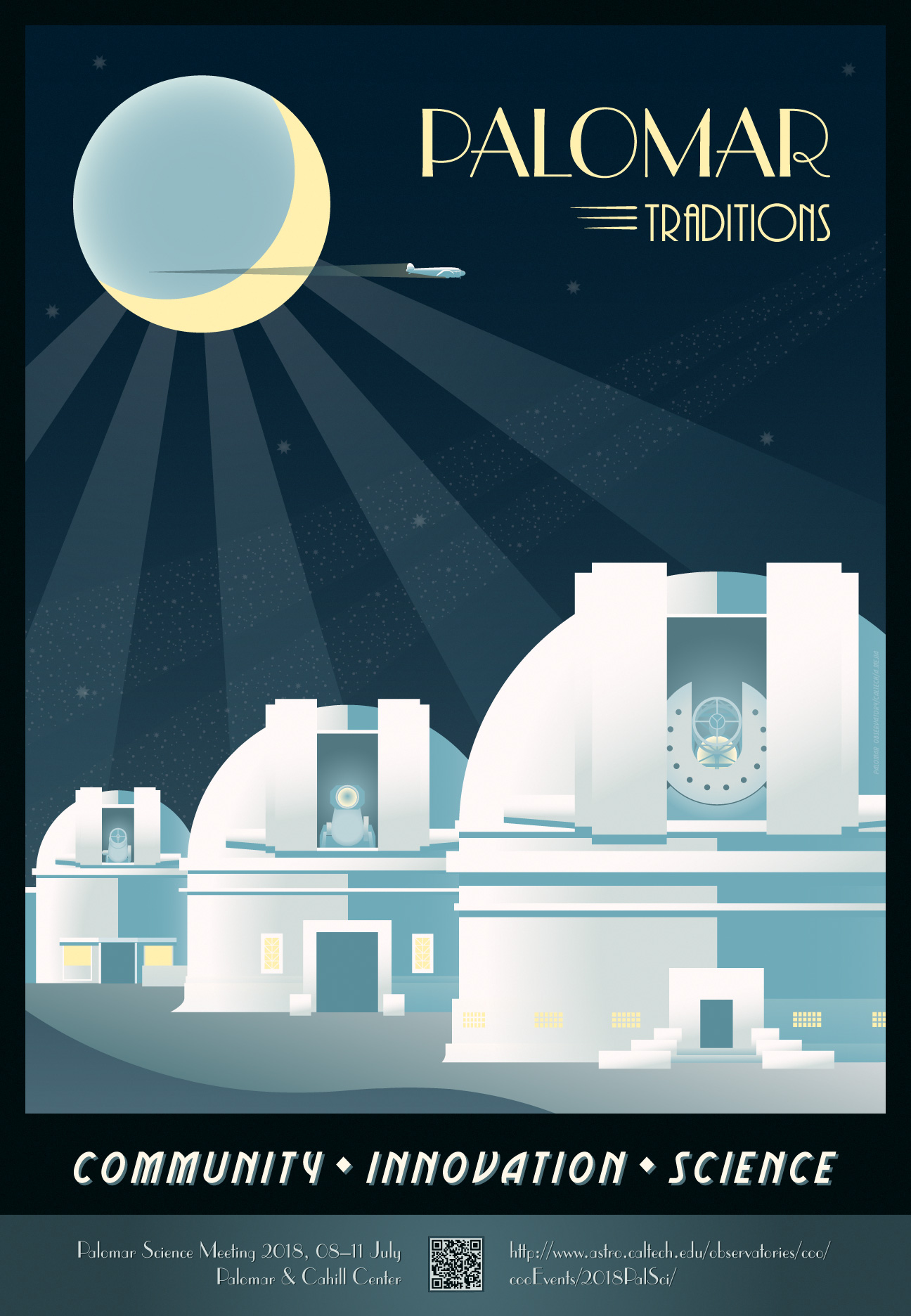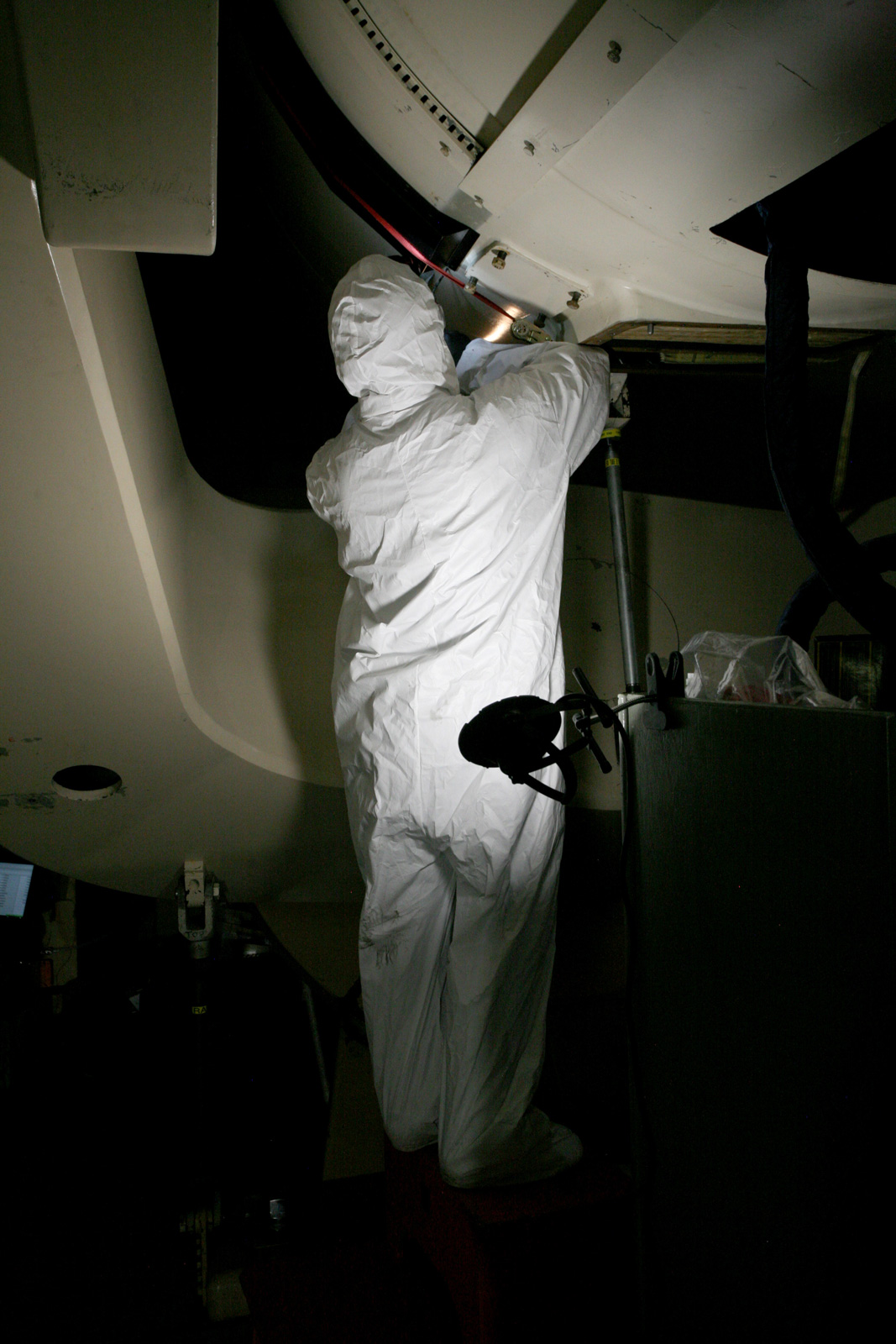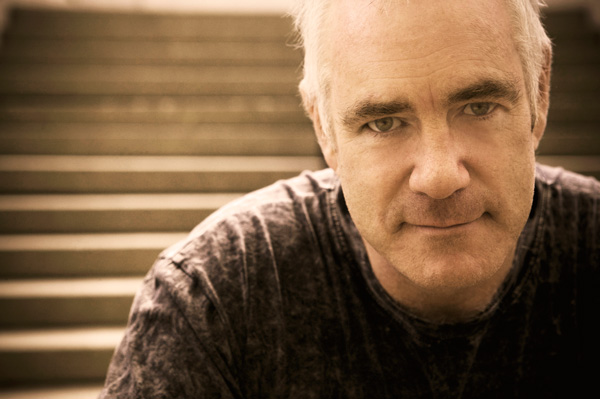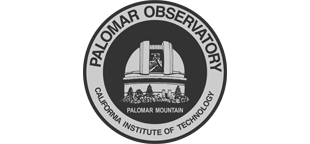
|
|

|
Friends of Palomar Observatory Events
Upcoming Events
No public events are planned at present. Please check back with us soon for the 2025 season!
Past Events
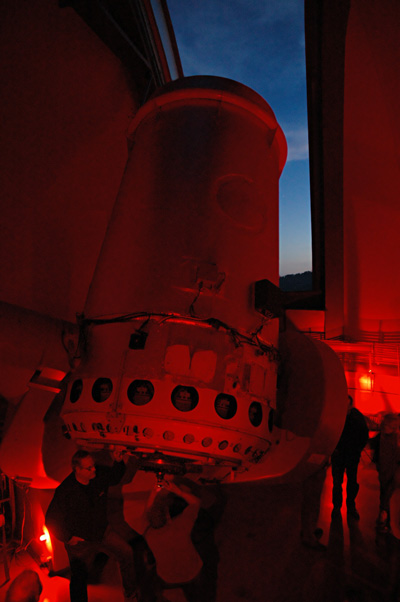
P60 observing. (Palomar/Caltech)
60-inch Observing Night – Steve Flanders (Palomar Observatory)
We are holding a two-part event at the Observatory on Saturday, July 27, 2024. During the first part of the evening, a presentation will be given at the Outreach Center. The speakers will discuss the history and science of Palomar Observatory beginning at 6:00pm.
The second half of this event will then be used for eyepiece observing on Palomar’s 60-inch telescope. With favorable weather conditions, we will have access to the many wonderful objects of the summer sky.
All FOPO members are welcome. If you have a family membership, your family is welcome too. I do, however, need to know how many people are planning to attend. So, please send an RSVP to flanders [at] caltech [dot] edu and let us know if you need a map.
Join us at the Observatory and help us restart our “Friends” program. And, you should come to this event if for no other reason than just to see the beauty of the summer Milky Way under the dark, clear skies of Palomar Mountain.
We look forward to greeting you at the Outreach Center on July 27.
Astronomical Interferometry and you (and Palomar) – Dr. Andy Boden (Caltech)
Saturday 16 May 2020, 11:00pm
On Saturday 16 May at 11am, Palomar's Deputy Director Dr. Andy Boden will be making a Zoom presentation titled “Astronomical Interferometry and you (and Palomar).” The Zoom link will be distributed to all the FOPO members shortly before the start of the presentation. Below is the abstract of the talk:

Andy Boden. (Palomar/Caltech)
In addition to the year of global pandemic, 2020 is the centennial anniversary for the first measurements of apparent stellar diameters beyond the Sun, using a special purpose interferometric "boom" on the 100-inch Hooker Telescope at Mt. Wilson. From there astronomical interferometric techniques blossomed episodically in optical, infrared, and radio wavelengths, and have been impactful in fields as diverse as star and planet formation and stellar astrophysics, to active galactic nucleii and super-massive black holes, and gravitational wave detection.
In this talk, Dr. Boden will be telling a story on several levels: in general how astronomical interferometry is a method utilizing our understanding of "light" to open certain windows on the universe that would otherwise be closed to us; the role that interferometry played in the Mt. Wilson and Palomar creation story and history; to the role that interferometry played in his own personal journey to Palomar Observatory. He hopes to leave you with a richer understanding of astronomical methods and the fundamental unity of measurements made with both filled aperture and "sparse" aperture methods.
The ALMA Revolution – Dr. Rachel Akeson (NASA Exoplanet Science Institute)
Saturday 27 July 2019, 6:00pm
On Saturday, July 27, Dr. Rachel Akeson, senior research scientist and acting manager of the NASA Exoplanet Science Institute, will give a presentation titled “The ALMA Revolution.” Dr. Akeson studies the formation of stars and planets using, among other techniques, the high angular resolution that can be obtained with interferometers at infrared to millimeter wavelengths. She is concerned with the structure and evolution of the gas disks found around many young stars which serve as reservoirs of material for the formation of planetary systems. In addition to her role at the NASA Exoplanet Science Institute, Dr. Akeson is also serving as the task lead for WFIRST support at Caltech’s Infrared Processing and Analysis Center (IPAC). The Wide-Field Infrared Survey Telescope (WFIRST) is expected to launch in the mid 2020s on a six year mission.
Four Bright Planets and the Moon
Sunday 15 September 2018, 6:00pm
On Saturday, September 15, we’re holding a star party at the Outreach Center starting at 6:00p. Everyone is invited to contribute to the desert potluck.
The event will start with a presentation titled “Palomar Observatory in the Popular Culture” by docent Mike Bertin. Sunset is at 7:00p and we’ll get out the telescopes soon after. FOPO members may bring telescopes and binoculars if they wish.
The Palomar Science Meeting
Sunday 8 – Wednesday 11 July 2018
To commemorate the Observatory’s 70th anniversary this year we are holding the 2018 edition of the Palomar Science Meeting 08 – 11 July at Palomar and the Caltech campus in Pasadena.
The 2018 Palomar Science Meeting (PSM2018) will be an inclusive opportunity for the Palomar community to gather in celebration of Observatory history, accomplishments, and bright future. Events at Palomar on 08 July will celebrate the history and legacy of the Hale and Samuel Oschin Telescopes, and provide an opportunity for participants to view these telescopes and recent renovations and enhancements at the Observatory. PSM2018 sessions 09 – 11 July 2018 at the Caltech campus in Pasadena will focus on recent Palomar science results, and center around a special public session Tuesday afternoon 10 July to dedicate the Zwicky Transient Facility. Further details on PSM2018 may be found at the meeting website.
As members of the Palomar community, Friends of Palomar Observatory are welcome to attend PSM2018. As attendance will be limited by venue capacity, individuals wishing to attend PSM2018 are strongly encouraged to register/RSVP for the meeting.
Tours of the Greenway Visitor Center, Samuel Oschin and Hale Telescopes
Saturday 14 October 2017, 3:00 pm
There is a single Friends of Palomar Observatory event left for the 2017 season. On Saturday, October 14, join us at the Outreach Center starting at 3:00 pm. We will hold a reception with light refreshments after which we will tour Museum to see its latest additions.
At about 4:30 pm, we will go to the 48 inch Samuel Oschin Schmidt Telescope for a tour of the instrument that performed the Palomar Sky Survey and is currently being upgraded for its role in the Zwicky Transient Factory. Please note that, because of the work going on in that regard, we may or may not be permitted in the building.
From the 48-inch telescope, we will proceed to the 200-inch dome for a tour of the Hale Telescope. At the close of this tour, we will remain on the observing floor for the opening of the dome. We expect that this event will be concluded by 7:30 pm.
The tour of October 14 represents a rare opportunity to see the Samuel Oschin Telescope. However, we are restricted in the number of people we can take on this tour. RSVP at sbf at astro.caltech.edu and spots will be offered on a first-come, first-served basis. All FOPO members are welcome but we cannot admit guests for this event. For family memberships, please provide the number of people in your RSVP (immediate family members only, please). Confirmation of your reservation will be sent by email up to the attendance limit. RSVPs received after the tour is full will be placed on the waiting list.
Kindly consider that this tour requires walking a mile or more, part of that in the dark. It is important to bring a flashlight and to be prepared for cool temperatures.
This tour will be a fine event to close the season.
Black Holes Last Tango in Space: LIGO and the Dawn of Gravitational-wave Astronomy – Dr. David Reitze (LIGO/Caltech)
Saturday 22 July 2017, 6:30 pm
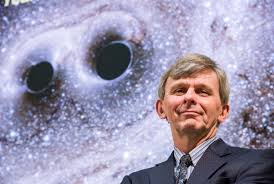
David Reitze. (Fundación BBVA)
Research Professor of Physics at Caltech and Executive Director of the LIGO Project David Reitze will speak to the Friends of Palomar at the Outreach Center on July 22.
Our evening will get started at 6:30 pm with a reception and light refreshments at the Outreach Center. Dr. Reitze’s presentation will begin at 7:00 pm and afterwards the docents will hold a star party on the basketball court behind the Outreach Center.
An RSVP would be appreciated and family members are welcome.
The Prevalence, Properties, and Architectures of Exoplanets – Dr. Erik Petigura (Caltech)
Saturday 6 May 2017, 6:30 pm
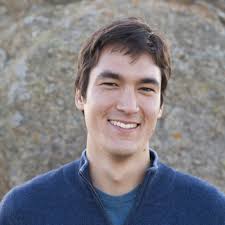
Erik Petigura. (E. Petigura)
Hubble Postdoctoral Fellow at Caltech Erik Petigura will present an overview of exoplanet demographics and will describe how this developing field of study may illuminate our understanding of the Earth’s history and the processes that led to development of life.
Join us on May 6 at 6:30 pm for a reception at the Palomar College Planetarium in San Marcos. Dr. Petigura’s talk will start at 7:00 pm after which Mark Lane, director of the Planetarium, will present a sky show. Here are directions to the Planetarium. Please park in the lot across the street from the Planetarium. No RSVP is needed and guests are welcome.
Abstract: Exoplanets orbit stars other than our Sun. At first, the study of these objects focused upon individual discoveries. But, thanks in large part to the many identifications made by NASA’s Kepler Mission, the direction of exoplanet research has changed. We now know, Dr. Petigura argues, that planets are common and that nature produces a rich diversity of planetary compositions and orbital architectures.
Prometheus Unwound – Larry Groupé (Composer)
Saturday 20 August 2016, 5:30 pm
Please join us at Palomar Observatory Saturday evening 20 August 2016 for the world premiere performance of "Prometheus Unwound"—an original string quartet celebrating the Observatory by composer and Palomar resident Larry Groupé.
Prometheus Unwound is four-movement original composition inspired by Mr. Groupé’s long connection with Palomar Observatory through its Friends organization.
The performance will be held on the observing floor of the 200-inch Hale Telescope, and will begin at 6:30 pm PDT. Before the performance the Observatory will host a reception at the Greenway Visitor Center starting at 5:30 pm.
Invitees may bring at most two guests to this event. RSVP with your total party size to Steve Flanders (sbf [at] astro.caltech.edu) not later than 5 pm PDT Monday 15 August 2016 so we may make appropriate arrangements. We apologize for any inconvenience, but the Hale dome cannot accommodate wheelchair-bound guests.
Solar Eclipses, 2016 and 2017 and More – Dr. Jay M. Pasachoff (Williams College)
Saturday 14 May 2016, 6:30 pm
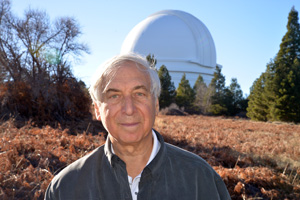
Jay Pasachoff. (J. Pasachoff/Williams College)
A veteran eclipse chaser, Jay Pasachoff has probably seen and studied more solar eclipses than anyone else on Earth, by one count, 65 eclipses between 1959 and the end of 2015. He has recently returned from an expedition to study the eclipse seen in Indonesia on March 9.
During his talk, Pasachoff will tell us about his experience at this March 9 event and discuss the circumstances of and his expectations for the total solar eclipse that will be visible along a narrow band that crosses the United States on August 21, 2017. In addition, he will describe the important science that he obtains by trekking to eclipse sites around the world.
This event, held at the Palomar College Planetarium in San Marcos, will begin with a reception at 6:30 pm. The talk will start at 7:00 pm and will be followed by a planetarium show. Please follow this link for directions.
Tours of the Samuel Oschin and Hale Telescopes
Saturday 17 October 2015, 3:00 pm
Meet us at the Outreach Center starting at 3:00 pm for a reception and a presentation. At 4:30 pm, we will go to the 48-inch Samuel Oschin Telescope for a tour of the instrument that performed the Palomar Sky Survey and is currently the survey instrument for the intermediate Palomar Transient Factory. Jean Mueller will conduct the tour. Jean worked on the second Palomar Sky Survey and is the Observatory’s long time telescope operator.
From the 48-inch telescope, we will proceed to the Hale Telescope dome for a tour of the 200-inch. At the close of this tour, we will remain on the observing floor for the opening of the dome. We expect that this event will be concluded by 7:30 pm.
Astro-Archaeology – Dr. Evan Kirby (Caltech)
Saturday 1 August 2015, 7:00 pm
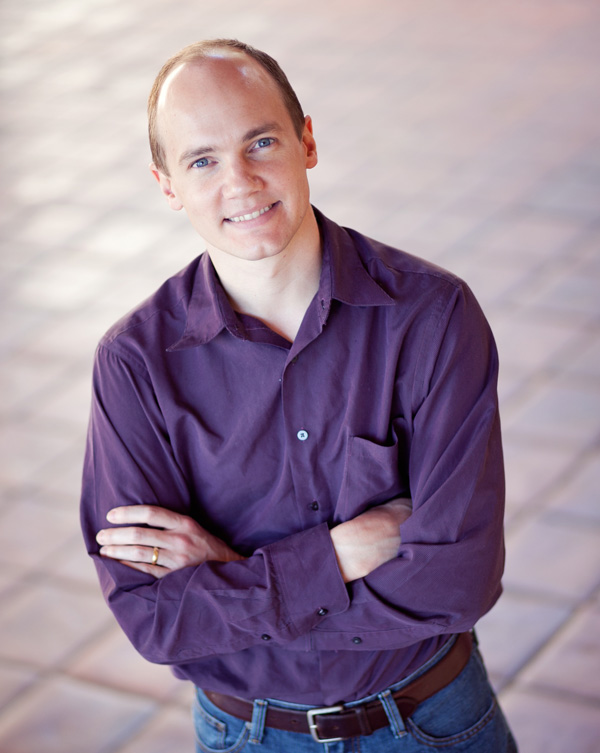
Evan Kirby. (T. Nguyen/Bamboo Shoots Photography)
First a Hubble Fellow at Caltech and later a Center for Galaxy Evolution Fellow at UC Irvine, Evan Kirby has returned to Caltech as an assistant professor. He specializes in understanding the dynamical and chemical evolution of dwarf galaxies, e.g., dwarfs in the Local Group orbiting and interacting with the Milky Way and Andromeda galaxies.
Join us for a reception at 6:30pm. Kirby's presentation will be followed by a star party at the Palomar Observatory Outreach Center.
Abstract: Caltech astronomers have gone on an archaeological road trip to the most remote neighborhoods of the Milky Way galaxy. These neighborhoods are peppered with mini-galaxies-within-a-galaxy that are sparsely populated with just handfuls of stars. Although these galaxies used to harbor supernovae that produced most of the elements in the periodic table, those factories were shuttered long ago. In this talk, we will uncover the history of these ghost towns—and their defunct manufacturing economies—by discovering what the few surviving stars are made of.
Mt. Wilson Observatory Tour
Saturday 27 June 2015, 11:00 am

The 100-inch Hooker Telescope at Mt. Wilson Observatory (D. Jurasevich)
The staff at Mt. Wilson Observatory has invited the Friends of Palomar for a two-hour tour on June 27 starting at 11:00 am. The event is limited to 30 people. RSVP to sbf [at] astro.caltech.edu—slots on the tour will be allocated on a "first-come" basis.
Please consider:
- The Mt. Wilson tour involves a great deal of walking over a period of two hours or more.
- Since everyone will be traveling in their personal vehicles, every vehicle will need to have a forest service parking permit. Day passes are available for $5 at Mt. Wilson's Cosmic Cafe.
- Lunch is not included, but Friends have the option of purchasing lunch at the Cosmic Cafe as long as their meal has been pre-ordered. Information may be found here.
Premiere Night at Palomar College Planetarium – sponsored jointly by Palomar College and Palomar Observatory
Saturday 25 April 2015, 7:00 pm
Join us for an engaging evening at the Palomar College Planetarium in San Marcos, where the program will include a double feature Stars—Powerhouses of the Universe and a talk on The Restless Universe by Shrinivas Kulkarni, Director of Caltech Optical Observatories.
Visit to Griffith Observatory
Saturday 27 September 2014, 10:00 am
All Friends of Palomar are welcome to join us for a guided tour of Griffith Observatory and a planetarium show.
Finding the Youngest Exoplanets: Palomar Observatory at the Forefront – Dr. David Ciardi (Caltech)
Saturday 12 July 2014, 7:00 pm
David Ciardi is a research astronomer from the NASA Exoplanet Science Institute at IPAC/Caltech. He has a large range of scientific interests that includes exoplanets, star formation, interstellar dust, and molecular clouds. His presentation will be followed by a star party at the Palomar Observatory Outreach Center.
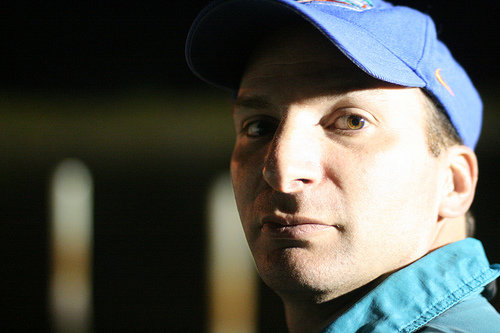
David Ciardi. (D. Ciardi/Caltech)
Abstract: Astonishingly, it has only been 25 years since the first discovery of planets around other stars. Since that time, astronomers, both professional and amateur, have discovered more 1,700 planets, not including an additional 2,600 to-be-confirmed candidates discovered by the Kepler Mission. Nearly all of these planets have been discovered around stars like our Sun, and one thing is clear from all of these discoveries, nature creates exoplanetary systems with a range of diversity. However, little is actually known about planets at the earliest stages of formation. Palomar Observatory has been used at the forefront of astronomy to search for and discover the first transiting exoplanet around a newly formed star. In his presentation, David Ciardi will describe the discovery of the first exoplanet in orbit around such a young star—at the cusp of formation. This detection was made at Palomar Observatory as part of the Palomar Transient Factory, and has since been confirmed in follow-up observations at other facilities including the Palomar 200-inch Telescope, the Keck Observatory, and the Spitzer Space Telescope.
The New Era of Exoplanet Direct Imaging – Dr. Sasha Hinkley (Caltech)
Saturday 26 April 2014, 7:00 pm
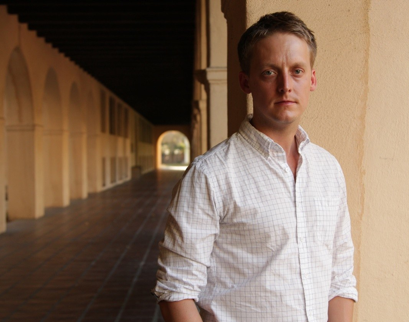
Sasha Hinkley. (S. Hinkley/Caltech)
Caltech Astronomer Sasha Hinkley will give at talk at the Planetarium at Palomar College. His talk will be followed by a planetarium show by Mark Lane, Assistant Professor of Astronomy and Director of the planetarium. Please RSVP to sbf at astro.caltech.edu or call (760) 742-2131.
Abstract: Most of the hundreds of extrasolar planets identified in the past 15 years have been detected indirectly throughcareful monitoring of the planets' effect on their host star's light. By overcoming the extremely large brightness ratio between the stars and their faint exoplanetary companions, we are now able to actually image wide-separation exoplanets using large ground-based observatories such as Palomar. Sasha will describe efforts spanning two hemispheres to implement a new generation of astronomical instruments at observatories like Palomar dedicated to this task. These instrumentation platforms will allow us to extract detailed spectroscopic information about exoplanets, providing insight into the atmospheric chemistries, compositions, and thermodynamic properties of these objects.
NASA's Kepler Mission: Discovering Strange New Worlds – Dr. William Welsh (San Diego State University)
Saturday 26 October 2013, 7:00 pm
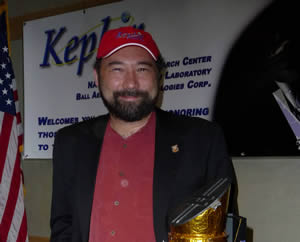
William Welsh with a model of the Kepler spacecraft. (W. Welsh)
William (Bill) Welsh is a Professor of Astronomy at San Diego State University, and a member of NASA's Kepler Mission. He has been very involved in the study of circumbinary planets, and led the discovery of two planets, Kepler-34 and Kepler-35.
Abstract: Over the past two decades hundreds of new planets have been discovered, but nearly all of these "exoplanets" are giant, Jupiter-size planets. Earth-like planets are much smaller and very much harder to find. NASA's Kepler Mission, launched in March 2009, has a precision 100x better than ground-based planet searches and is the first telescope capable of detecting Earth-size planets orbiting a star like the Sun. In this talk I will present the results of Kepler's search for terrestrial planets, and will also highlight some of the strange and wonderful discoveries Kepler has made. In particular, I will discuss a new class of planets Kepler has found, the "circumbinary planets." These are planets orbiting around a pair of stars, and have two suns in their sky.
"Super" Supernovae and the Quest for the First Stars – Dr. Jeff Cooke (Swinburne University)
Saturday 21 September 2013, 7:00pm – 10:00pm
Jeff Cooke is a Research Fellow at Swinburne University in Melbourne, Australia. Previously, he was a McCue Postdoctoral Fellow at the University of California, Irvine and a Postdoctoral Scholar at California Institute of Technology (Caltech). Dr. Cooke received his B.S. in Astronomy at San Diego State University and his M.S. and Ph.D. in Physics at the University of California, San Diego. His work spans a broad range of topics from galaxy formation and evolution, to quasar absorption-line systems, to supernovae. He holds the record for the most distant supernova, a record he continues to break.
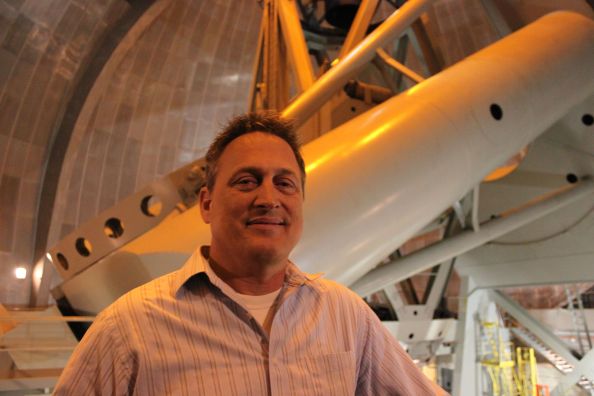
Jeff Cooke and the Hale Telescope. (J. Cooke)
Abstract: Very massive stars end their short lives in extremely violent and luminous supernova explosions that can be seen out to great distances. Using a new method, our team has discovered supernovae out to distances much farther than has been previously possible - distances that equate to explosions that occurred 10-12 billion years ago. Several of our discoveries are 10-100 times more luminous than normal supernovae and belong to a rare class of "super-luminous" supernovae. Interestingly, two of these "super-luminous" supernovae may be the first bona-fide examples of a long-theorized third type of supernova explosion believed to have been more common in the early Universe. New surveys now underway will allow us to detect these "super" events all the way back to when the first stars formed after the Big Bang. I will show how we are hot on the trail to discover the deaths of these first stars.
Visit to the New Palomar College Planetarium
Saturday 24 August 2013, 6:00pm – 7:30pm
The Sky Tonight and Undiscovered Worlds—a full dome presentation.
Are Supernovae Round? – Dr. Douglas Leonard (San Diego State University)
Saturday 13 July 2013, 7:00pm
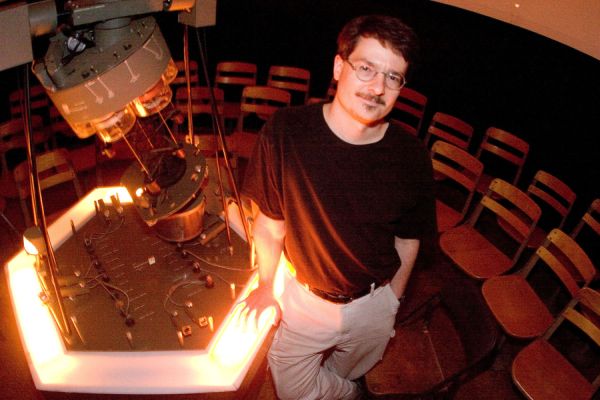
Douglas Leonard. (K.Calligan/Daily Aztec)
Douglas Leonard is Associate Professor of Astronomy at San Diego State University, having previously served as National Science Foundation Astronomy and Astrophysics Postdoctoral Scholar at the California Institute of Technology and, prior to that, as a Postdoctoral Fellow with the Five College Astronomy Department in Amherst, MA. Dr. Leonard received his B.A. in astronomy from the University of Pennsylvania, and his M.S., and Ph.D. in astrophysics from the University of California, Berkeley. His publications include over 50 articles in the technical literature. A passionate science educator, his latest endeavors include work on several BBC/Horizon videos on black holes, cosmology, and the deaths of stars.
Abstract: Roughly once per century in a typical galaxy, a massive star ends its life in a spectacular explosion called a supernova. The physical process by which these stars explode, however, remains a mystery. Conventional wisdom holds that a spherically symmetric mechanism is at work, one that expels the ejecta equally in all directions. Using recent evidence derived from a novel observational technique employed at the world's largest optical telescopes (including the Hale), I will argue that the innermost regions of these stellar explosions are, in fact, severely distorted, the result of an explosion mechanism that is strongly non-spherical in nature.
Observing and Imaging Our Sun – Jim Lafferty
Saturday 15 June 2013, Solar Observing 12:00 pm, Presentation 2:00 pm
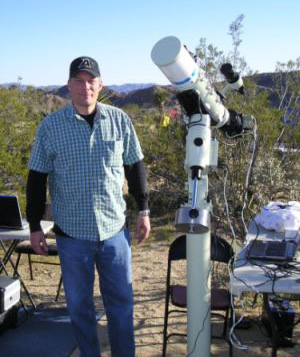
Jim Lafferty and his Takahashi FSQ106N. (J. Lafferty)
Jim Lafferty hails from Redlands, in Southern California, and has been an amateur astronomer for 35 years. After many years of visual observing, he took on nighttime deep sky imaging. In 2010, he got the solar "bug" and turned from the "dark side" to the adventure that is imaging the Sun. Observing and imaging our nearest star in both traditional "white light" and in the specific band of hydrogen alpha, Jim's work has been featured in Sky and Telescope Magazine, Astronomy Magazine, the UK's "The Astronomer", Amateur Astronomy Magazine, NASA's APOD, Space.com, Yahoo News, numerous blogs and online astronomy sites, and in High School Physics Textbooks. Jim also participates in various public outreach events, as well as giving presentations on the sun in the classroom. He is the author and publisher of the full color hardcover book Imaging Our Sun (2012).
For this presentation, Jim will walk us through the basics of observing and imaging the Sun with both hydrogen alpha and white light filtered telescopes. We will discuss the solar features you can expect to see through the eyepiece and some basic info on the best ways to image the sun. Some details on the most common equipment and software will also be discussed.
There will be solar observing at the Outreach Center 12:00 – 5:00pm.
The Search for AM CVn Systems with the Palomar Transient Factory – David Levitan (Caltech)
Saturday 11 May 2013, 7:00 pm
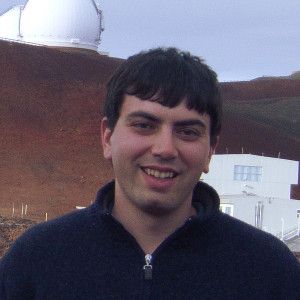
David Levitan at the Keck Observatory, Mauna Kea. (D. Levitan)
Abstract: Among the most exotic "stars" known are the AM CVn systems—ultra-compact binaries with orbital periods less than an hour. Their extremely short orbital periods make them strong Galactic sources of gravitational waves, but no one has yet understood how many of them exist in the Galaxy. I will describe these systems and why understanding their population is essential, and show how we use the Palomar and Keck telescopes to find new systems and by doing so, better determine their population.
Questions? We've answered many common visiting, media, and academic questions in our public FAQ page.
Please share your feedback on this page at the
COO Feedback portal.
Events / v 1.0.17
Last updated: 6 April 2025 ACM
|
|
|
